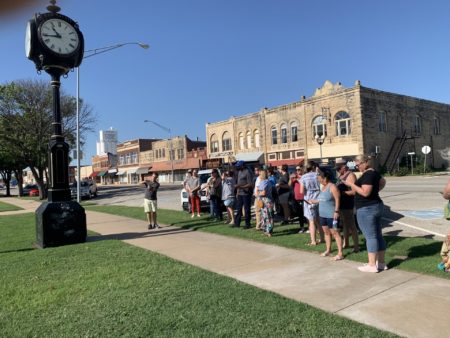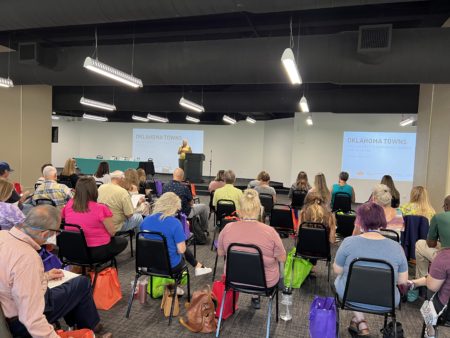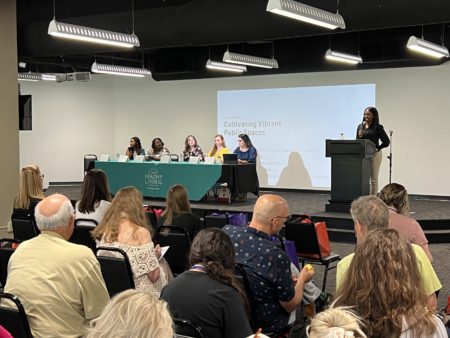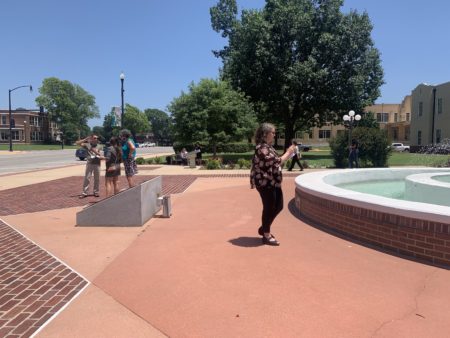This summer the IQC (Institute for Quality Communities) partnered with Kay County TSET (Tobacco Settlement Endowment Trust) and to host the first ever Oklahoma Towns: Walkability and Placemaking Summit. Due to COVID-19, the highly anticipated biennial Placemaking Conference had been paused since its last debut in Spring 2019. (We hope you are looking to welcoming back this event as much as we are for Spring 2023.) This summit infused a much-needed in-person gathering to encourage planners, citizens, and healthy living advocates with ideas and success stories ranging from tactical urbanism to permanent projects from across the state.
The summit kicked off on June 13 with a tour of downtown Newkirk. The town of Newkirk collaborated Trifecta Communications out of Oklahoma City to create a digital storytelling tour app for mobile devices, displaying different buildings and points of interest through a timeline of historic photographs, some dating over a century old. A truly unique method for experiencing and learning about historic preservation and local history. Trifecta Communications mentioned their partnerships with several other Oklahoma communities for this project.

![]()
On June 14, attendees gathered in Ponca City for an itinerary-packed day of walkability and placemaking content. Jenny Creech, Program Coordinator for Kay County’s TSET Healthy Living Program kicked off the day with a warm welcome to start the day. Shane Hampton, Director of OU’s IQC, gave an informative presentation on how walkability, placemaking, and connectivity all intertwine. Hampton then led a panel discussion highlighting project success stories from Doug Walton of Muskogee County Health Department and Kelly Martin of Tonkawa Public Schools. Both community leaders inspired us to be healthy living advocates in our own communities and to use outside-the-box problem solving skills to build consensus to implement tangible results.![]()

Vanessa Morrison, Associate Director of OU’s IQC, led a panelist discussion on cultivating vibrant public spaces. The panel was made up of Gloria Torres of Capitol Hill neighborhood, Kelsey Wagner of My Media Matters, Kelly Tompkins of Hive Appeal, along with Helen Palmer and LaToya Mason of Northeast OKC Renaissance. These panelists highlighted the importance of community engagement, collaborative partnerships, and funding sources. One specific grant utilized was the T-Mobile Rural Hometown Grant that is open for U.S. communities of less than 50,000 in population. To find out more about this grant opportunity for your hometown, click here.

After lunch, an interactive workshop was held as attendees formed small breakout groups using The Place Game, a resource of Project for Public Spaces, to evaluate walkability and placemaking of public spaces in downtown Ponca City. This exercise gave attendees a tool to take back to their own communities to identify assets and areas in need of improvement to create great walkability and increase a sense of place. To learn more about The Place Game, you can visit here. Groups reassembled to share their observations and ideas, while Shane Hampton, Director of OU’s IQC, facilitated the discussion.

In closing, Ron Frantz, Director of Small Town Studios for OU’s IQC debriefed the conference content and activities. Many rankings of where our state falls in line compared to other states in the areas of public health, education and quality of life were shared. Ron referenced a local book recently published in 2021 entitled Oklahoma Pride: Working Together for the Well-being of All Oklahomans by Gary E. Raskob with a forward by Gene Rainbolt. Ron shared thought-provoking words and meaningful statistics that show Oklahoma’s low rankings across various categories that impact an individual’s quality of life. A true reminder of just how meaningful the work is that we all do to bring communities together, promote healthy living and make communities across our state more desirable for future generations to enjoy and prosper. You can read more about the creation of this book in the Journal Record or by visiting the OU blog.
![]()
![]()
![]()
![]()
